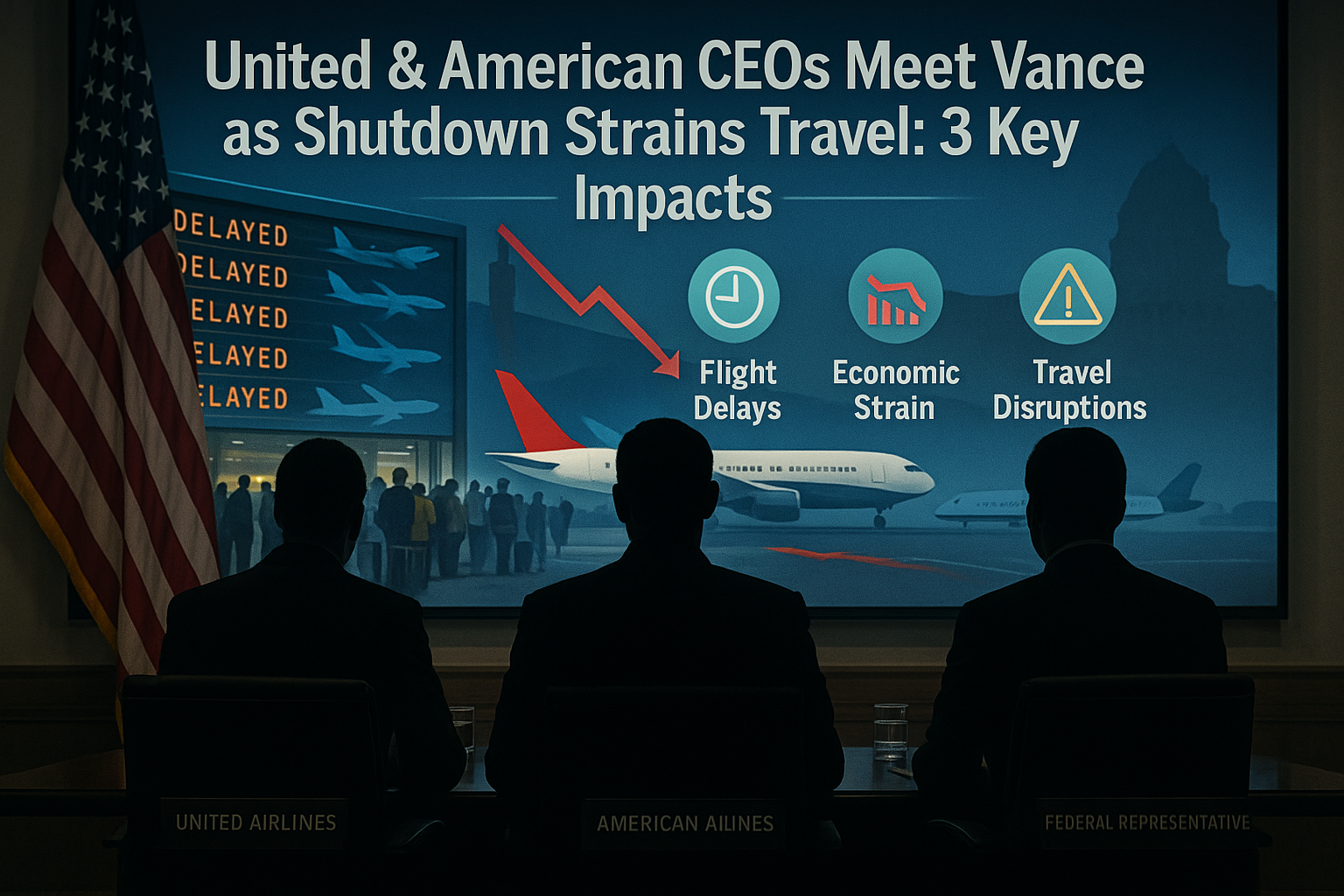When the government shutters major funding, ripple effects follow—and right now the travel industry is feeling every ripple. The moment this story turned urgent: United Airlines and American Airlines—two of the biggest names in U.S. aviation—sent their top executives to meet J.D. Vance. That meeting, held at the White House, underscores how a shutdown isn’t just a political squabble—it’s a direct hit to travel.
In this article, we’ll walk through what’s happening, why it matters, and what travelers and industry watchers need to know. Yes—you’ll hear about the shutdown. Yes—you’ll hear about CEOs. And yes—you’ll hear about Vance. Because together they’re shaping exactly how this travel strain plays out.
What triggered the meeting?
The trigger is the ongoing federal halt of funding—commonly referred to as the “shutdown.” The 2025 shutdown of the U.S. federal government has now been linked to severe strains on travel infrastructure.
Here’s a breakdown of the chain of events:
- A stalemate in Congress left key agencies unfunded.
- Among the affected are aviation-support services: air traffic control staffing, TSA screeners, facility inspections.
- Flight delays and disruptions soared. For example: nearly 44 % of Monday delays tied to controller absences.
- The CEOs of United and American Airlines flagged this publicly and asked for intervention.
- Vice President Vance convened the roundtable to press the issue.
When executives from giant airlines show up in the Oval Office? That’s no coincidence. It’s a signal: travel is being squeezed—and time is running out.
Who’s at the table and why it matters
Understanding participants helps clarify stakes—and this table is packed.
- United Airlines CEO Scott Kirby and American Airlines CEO Robert Isom. They represent thousands of flights and millions of passengers.
- Vice President J.D. Vance and Transportation Secretary Sean Duffy. Representing the political/administrative side.
- Industry trade and labour group leaders (for example, Air Line Pilots Association and the International Brotherhood of Teamsters). Their presence signals workforce stress.
Why it matters: when senior airline executives meet top government officials, it’s a recognition that operational issues have become strategic risks—public, visible, and urgent.
Key travel-industry impacts of the shutdown
Let’s dive into the actual effects. These aren’t abstract—folks are feeling them.
1. Increased flight delays & cancellations
The shutdown has left large numbers of federal workers unpaid. For example: 13,000 air traffic controllers and 50,000 TSA officers reportedly working without pay. The result? More absences, less redundancy, longer delays. Anecdotal data: 44 % of delays were linked to controller absence on one Sunday.
2. Reduced operational flexibility
Airlines operate on thin margins when everything’s humming. But when inspections are postponed, training suspended, back-up capacity eroded—system resilience drops quickly. The travel industry is now warning of “disaster” if this drags into prime travel season.
3. Consumer confidence shakes
Travellers notice. Flights get delayed, rebooked, or cancelled. Industry leaders say bookings are already being impacted as people hesitate. A delay isn’t just a time-lost; it chips at trust.
What the CEOs and Vance are asking for
What do United, American and the government want? A few clear asks:
- A “clean” continuing resolution (CR) to reopen government funding without additional policy riders.
- Prioritising aviation-critical functions: controller hiring/retention, screening, inspections.
- Messaging: the travel sector must remain safe and reliable, even under stress. Vance emphasised the “safest aviation industry in the world” is facing risk.
In essence: fix the funding log-jam so the system can breathe again.
Why this matters beyond airlines
You might wonder: is this just about flights? Not at all. The impacts radiate outward.
- Economic: Airports are major employment hubs; delays ripple into hotels, tourism, conferences.
- Personal: People planning holiday travel, family visits, business trips—all may face uncertainty.
- National: Aviation is interlinked with supply chains, security, international mobility and the broader economy.
- Political: This event becomes a leverage point in budget negotiations—air travel delays translate into public pressure. Vance used the travel disruptions to apply pressure.
What travelers and industry watchers should do now
Here’s some practical guidance:
- Monitor airlines’ communications: With staffing squeezed, airlines may proactively adjust schedules.
- Choose flexible tickets where possible: Travel plans may need adjustments.
- Arrive earlier to airports: Screening and traffic control may take longer.
- Track government funding developments: A reopening bill could ease pressure quickly; a drawn-out impasse might worsen things.
- For those in the industry: Prepare contingency plans, manage workforce stress, and communicate clearly with customers.
Looking ahead: what to watch
A few indicators will reveal how the situation evolves:
- Congressional action: Does a clean CR pass or does funding remain stalled?
- Staffing data: Absence rates among controllers and screeners, or major cancellations.
- Airline performance: If delays begin climbing into 30-40 % regularly—another red flag.
- Holiday season booking trends: If travellers start skipping or shifting trips due to perceived risk.
- Messaging from execs: If CEOs escalate their warnings, we’re likely reaching a tipping point.
The meeting between United & American CEOs and Vance signals the gravity of the moment—and we’re in the lead-up to some potentially consequential developments.
FAQs
Q: Why are the CEOs of United and American Airlines meeting Vice President Vance?
They are meeting because the federal shutdown is placing strain on aviation functions—crew scheduling, air traffic control, TSA screening—and they want urgent government action to avoid major travel disruptions.
Q: What parts of air travel are being impacted by the shutdown?
Key functions such as air traffic controller staffing, security screening by TSA, and facility inspections are being stressed. As a result, delays and cancellations are rising.
Q: How serious are the delays?
Some data show that on a recent Sunday, 44 % of delays were attributed to controller absences. This is far above typical levels.
Q: What is a “clean” continuing resolution and why do the airlines want it?
A “clean” CR is a stop-gap funding measure passed without extra policy conditions. Airlines want a clean CR to restore funding quickly without entangling additional policy debates.
Q: Should travelers postpone trips because of this?
Not necessarily postpone, but they should stay vigilant. Monitor airline notices, seek flexible booking options, and plan for potential delays, especially if traveling during peak periods.
Q: What happens if the shutdown drags on through Thanksgiving or the holiday season?
The risk spikes. Travel volume increases, so any system strain is amplified. Industry leaders are warning of a potential “disaster” for travel if operations remain stressed.


